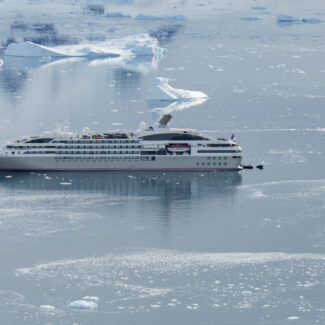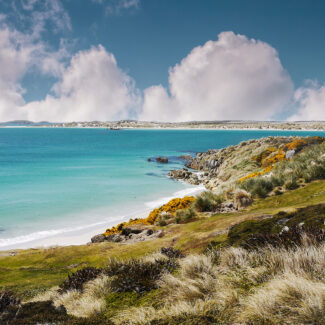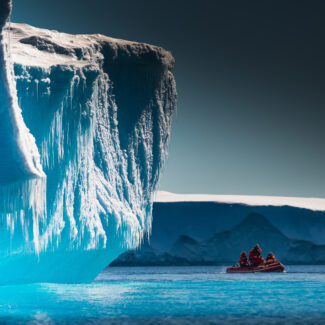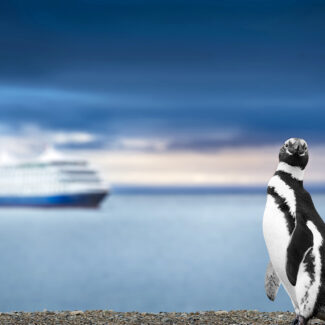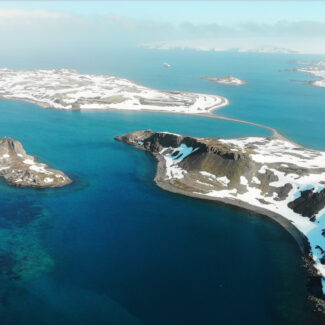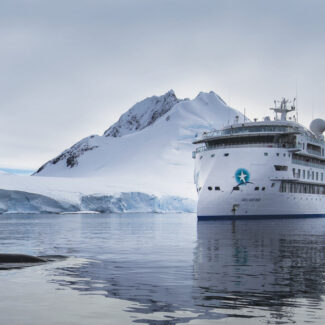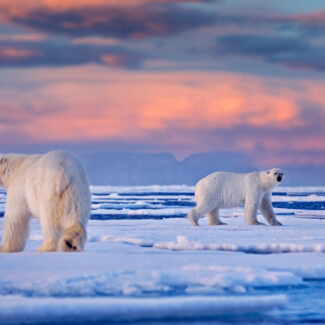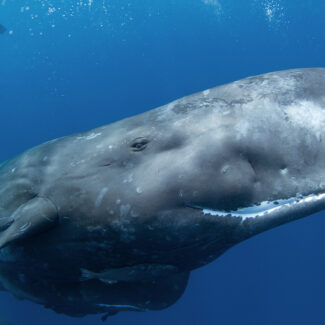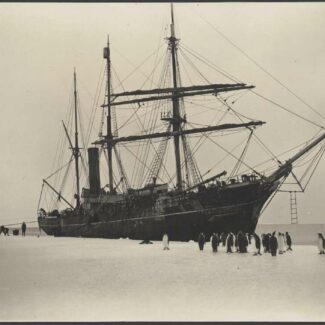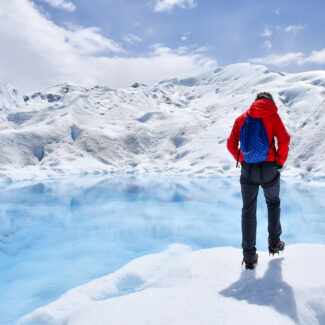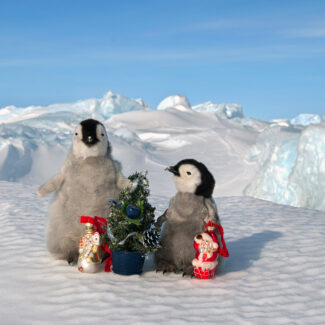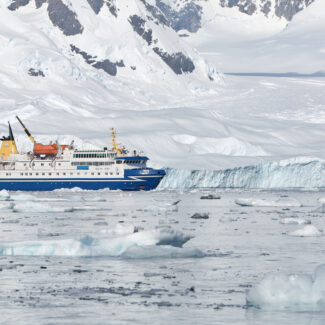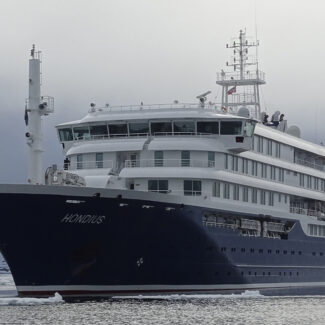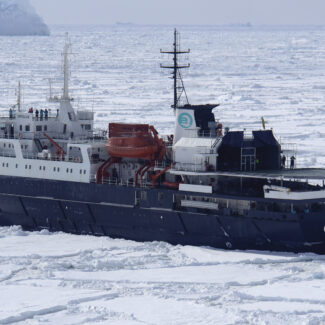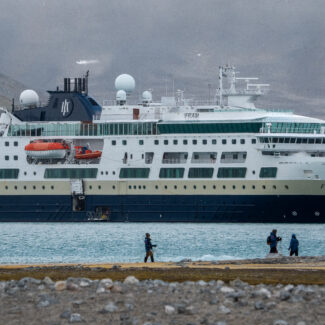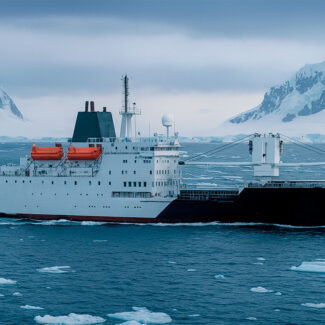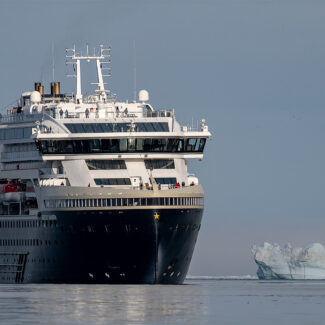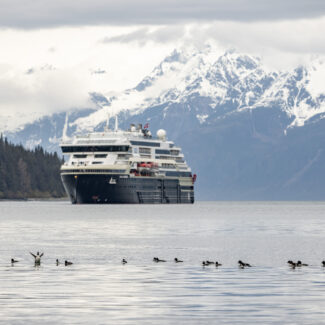8 Howling Facts About Arctic Wolves
- (1) We Don’t Fully Have a Grasp on Their Taxonomy
- (2) The Arctic Wolf Proper Inhabits the High Arctic of Canada & Greenland
- (3) They’ve Expanded & Contracted in Range in Concert With Glacial Cycles
- (4) They’re Known For Their Mainly White Fur—and Some Big Teeth
- (5) Caribou, Muskoxen—and Arctic Hares—Are Among Their Primary Eats
- (6) They Often Form Smaller Packs Than More Southerly Gray Wolves, and Cover a Lot of Ground
- (7) They Have Their Very Own Howling Dialect
- (8) Climate Change May Spell Major Changes for the Arctic Wolf
- Where to See Arctic Wolves
The gray wolf ranges widely north of the Arctic Circle in both North American and Eurasia, finding one of its last great dominions in the Far North, where human persecution in general has been less than at lower latitudes. Indeed, wolf range in the Arctic and sub-Arctic is more intact than anywhere else in the world.
In one particular corner of the Arctic—the High Arctic islands of Canada as well as adjacent Greenland—one subspecies of gray wolf has specially adapted to the extremes of this remote mosaic of tundra and rock barrens: the Arctic wolf, the famed, elusive, and under-studied “white wolf” at the top of the world.
Read on for some howling (in both the “great” and literal sense) Arctic wolf facts!
(1) We Don’t Fully Have a Grasp on Their Taxonomy
The taxonomy, or biological classification, of wolves in the Arctic is not clear-cut, and continues to be in scientific focus. This is in large part simply a reflection of the fact that the genetic diversity and evolutionary kinships contained within the world’s population of gray wolves are themselves still being sorted out. That’s not really surprising, given the gray wolf (Canis lupus) is the most widely distributed large carnivore on Earth and exhibits an impressive diversity of morphology and ecological lifeways across its vast range, which includes everything from the sand deserts of the Arabian Peninsula to, yes, the sprawling “barren grounds” of the High Arctic.
We don’t have nearly the space to give full justice to the still-muddled state of scientific understanding on this topic. Historically, various scientists described a number of different Arctic and sub-Arctic subspecies of gray wolves, from the tundra wolf (C.l. albos) of the Eurasian Arctic and the Alaskan tundra wolf (C.l. tundrarum) of the coastal mainland Arctic of Alaska and Canada to the Greenland wolf (C.l. orion) and the Baffin Island wolf (C.l. manningyi). As for many other critters, the powers of modern genetic analysis has led to taxonomists lumping together numerous previously defined subspecies. One widely cited 1995 analysis by Ronald M. Nowak proposed five subspecies of gray wolves in North America, three of which include the Arctic in their range: C.l. occidentalis in Arctic Alaska and the western mainland Arctic of Canada; C.l. nubilus reaching the central and eastern Canadian Arctic, including Baffin Island; and the “true” Arctic wolf, C.l. arctos—sometimes (and perhaps more descriptively) also called the High Arctic wolf—which Nowak mapped across much of the Canadian Arctic Archipelago to Ellesmere Island and northern Greenland.
A 2018 study, meanwhile, which analyzed dozens of full genome sequences of North American wolves and “wolf-like canids,” suggested three distinct populations in the continent’s High Arctic realm: West Arctic wolves and East Arctic wolves within the Arctic Archipelago, and then the “polar wolf” of the Queen Elizabeth Islands (including Ellesmere Island) and Greenland. That research suggested the West and East Arctic wolves had greater genetic overlap with wolves from mainland populations in the Arctic, with polar wolves being the most genetically distinct.
In this article, in line with the approach taken by a number of researchers, we’ll use the term “Arctic wolf” to refer to the wolves of the North American High Arctic: that is, the Canadian Arctic Archipelago and northern Greenland. Technically speaking, the wolves of Baffin Island—the biggest island in the Arctic Archipelago—appear to show more genetic kinship with mainland wolves, which has prompted some scientists to lump Baffin Island wolves with the widespread mainland C.l. nubilus subspecies. But Baffin Island wolves also show genetic, morphological, and behavioral overlap with other Arctic Archipelago wolves, so for our purposes we’ll include them as Arctic wolves.
The beauty of these arctic wolves is undeniable, but their exact place in the family tree still holds mysteries! Scientists are continuously working to unravel the complexities of their taxonomy, reminding us how much there is still to learn about these magnificent creatures of the North.
(2) The Arctic Wolf Proper Inhabits the High Arctic of Canada & Greenland
Wolves are found throughout the Arctic, with what are sometimes loosely called “tundra wolves” roaming across most of the mainland Arctic regions of Russia, Alaska, and Canada. Wolves are found on some Russian High Arctic islands, including Severynaya Zemyla and the New Siberian Islands. Gray-wolf range is certainly also extensive in the sub-Arctic boreal forest or taiga south of the Arctic Circle.
The Arctic wolf, as we’ve defined it, is found in the North American High Arctic: much of the Canadian Arctic Archipelago and far northern Greenland, a treeless realm of tundra, gravel, bedrock, ice, and frigid waterways. But the distribution of Arctic wolves within this range has apparently always been uneven, wolf-less areas extensive on account of unfavorable habitat or insufficient prey. Human activities have also affected the distribution of Arctic wolves. For example, hunting eliminated the historic population of East Greenland by the 1930s. In the late 1970s, wolves from northern Greenland, where the species had persisted, recolonized East Greenland and resulted in a small population of 20-odd wolves, which for reasons not entirely understood declined and apparently disappeared by the early 2000s. The relatively small population of North Greenland wolves remains within Northeast Greenland National Park (a different portion of which—this is the biggest national park in the world, mind you—supported that short-lived modern population of East Greenland wolves).
Arctic wolves also exist in low densities, a consequence of their lean ecosystem.
In the heart of a snowy wilderness, this majestic creature epitomizes the spirit of the High Arctic! The arctic wolf proper makes its home in the remote, icy expanses of Canada and Greenland, a testament to its incredible resilience and adaptation to one of the planet’s most extreme environments.
(3) They’ve Expanded & Contracted in Range in Concert With Glacial Cycles
Wolves have been present in the High Arctic since the Pleistocene, and the drastic changes to landscapes, seascapes, climate, and ecology associated with advances and retreats of ice sheets and glaciers have likely played a foundational role in their distribution as well as their degree of uniqueness compared with mainland wolves. During glacial advances, Arctic wolves would have been restricted to rare ice-free zones that supported enough prey, especially large ungulates such as muskoxen and caribou.
During the Last Glacial Maximum (LGM), High Arctic wolves in North America may have been confined to ice-free refugia on Ellesmere Island and/or northern Greenland’s Peary Land peninsula. Today’s Arctic wolves may derive from that refugia, having expanded their range in the Arctic Archipelago since the retreat of the ice sheets.
A 2008 study published in Conservation Genetics notes that the climatic and physical challenges of the High Arctic and the uneven distribution and population variability of suitable wolf prey here mean that Arctic wolves may experience recurring cycles of range contraction/local extinction and range expansion/recolonization. Glaciation patterns and their impacts on available habitat and prey bases in this island region are one foundational reason. But so are crashes in prey populations on certain islands due to shorter-term climate and weather events, disease, overhunting, and other factors. And certainly hunting of wolves by humans can eliminate a given Arctic area’s wolf population. With seasonal sea ice affording connection between High Arctic islands for terrestrial beasts, wolf-free areas may be eventually recolonized by wolves dispersing from other islands or from the Arctic mainland.
One impetus for recolonization might be the movements of prey. For example, the 2008 Conservation Genetics article notes that wolves from the Canadian mainland might have colonized Victoria Island in the course of trailing the migration of the Dolphin-Union caribou herd, which winters on the mainland and calves on the island.

Witnessing the tender bond between an arctic wolf and its pups reminds us of their enduring spirit! These resilient animals have seen their range expand and contract over millennia, adapting to the dramatic shifts of glacial cycles—a true testament to their ancient lineage and survival prowess.
(4) They’re Known For Their Mainly White Fur—and Some Big Teeth
Arctic wolves are medium-sized for gray wolves, generally weighing some 70 to 150 pounds. Their most characteristic feature is their pelage: a luxuriantly thick, and typically white, coat. A 1997-1999 study in the central Canadian Low Arctic found that 90% of wolves captured for telemetry tracking were white or near-white, with the small remainder being black or brownish-black.
None other than Charles Darwin, the famous zoologist who proposed the theory of evolution by natural selection, suggested (back in 1874) that Arctic wolves were white because the color afforded them camouflage in an environment that’s snow-covered most of the year. Indeed, while lower-latitude wolves may turn whitish with age, it’s comparatively rare to see wolves born white-furred south of the Canadian Arctic.
Along with the predominantly white hue, Arctic wolves are distinguished by notably large carnassial teeth compared with other gray-wolf types: a primary basis for the original classification of the C.l. arctos subspecies.
With its pristine white fur and powerful teeth, this arctic wolf is perfectly equipped for life in the frozen North! These magnificent features are essential for survival, allowing them to blend into snowy landscapes and efficiently hunt their prey, showcasing nature’s incredible design.
(5) Caribou, Muskoxen—and Arctic Hares—Are Among Their Primary Eats
Like other gray wolves, Arctic wolves are hypercarnivorous, getting most of their subsistence from meat—freshly killed and scavenged, both. Ungulates, the mainstay of gray-wolf diet in most corners of the world, are indeed heavily relied on by the Arctic wolf. Muskoxen and caribou are the linchpin ungulate prey for this wolf. Arctic hares, meanwhile, appear to be a significant supplementary food item, and—as a 2018 study from Ellesmere Island and northwestern Greenland suggested—may even sustain Arctic wolves where ungulates are absent.
In much of the Low Arctic of North America and Eurasia, caribou (reindeer) as well as moose are preferred wolf prey. In the mainland Arctic, wolf packs may follow the migration of barren-ground caribou. Muskoxen are available in some parts of the Low Arctic, but become a more significant prey item in the High Arctic, with caribou—where available—remaining important as well, supplemented by Arctic hares as well as lemmings. Other prey may certainly be taken, including waterfowl and, on occasion, seals. Researchers have even documented Arctic wolves killing polar-bear cubs from time to time.
Though wolves absolutely take down adult muskoxen, they certainly prize the less-formidable calves available during the summer (though full-grown muskoxen are still preyed upon in that season). Muskoxen have evolved an impressive defense strategy to protect their vulnerable young, with adults in a herd ringing themselves horns out around calves upon detecting wolves. Wolves typically have greater success by somehow getting the herd on the run.
This powerful image captures a vital moment in the Arctic food chain. While caribou and muskoxen are crucial, arctic hares also form a significant part of the arctic wolf’s diet, demonstrating the intricate balance of life in this challenging environment.
(6) They Often Form Smaller Packs Than More Southerly Gray Wolves, and Cover a Lot of Ground
Wolf packs typically consist of a breeding pair and their offspring, including yearlings and adult progeny that may eventually disperse after a few years. Reflecting the typically lower prey densities in their realm, Arctic wolves often live in smaller packs as compared with their more southerly brethren. That said, a 2024 Journal of Wildlife Management paper on research from Ellesmere and Axel Heiberg islands found a mean pack size of about five adults with the largest documented pack comprising 10 adults and 11 pups—pretty comparable to wolves in boreal and temperate areas of North America, though absolutely larger average pack sizes are known from those zones. Packs of about 20 wolves have been documented on Ellesmere Island, but most Arctic packs are much smaller.
Research in Greenland, where prey densities can be very low, showed that pairs were the primary social grouping among Arctic wolves there, with packs greater than four adults rare. Lone wolves were also commonly observed, especially in early and late winter.
The aforementioned 2024 paper showed that Ellesmere Island and Alex Heiberg Island wolves maintain territories year-round, as in most corners of gray-wolf country, with summertime territories that ranged between 154 and 822 square miles (400 and 2,130 square kilometers). A study on Ellesmere Island that GPS-collared the alpha male wolf of a large pack and tracked his (and presumably his pack’s) movements between July 2009 and mid-April 2010 documented a range of 2,564 square miles (5,979 square kilometers), perhaps the largest territory recorded for a well-established wolf pack. This collared wolf covered an impressive 47 straight-line miles (75.9 kilometers) in one 12-hour period. That study, the first of its kind to track Arctic wolves during the winter, suggested that particular pack didn’t show any pronounced change in movements during that season’s extended darkness.
United and ever-vigilant, these arctic wolves are a testament to efficient living in the vast Arctic! Unlike their southerly cousins, they often form smaller, tight-knit packs, perfectly adapted to covering immense territories in their relentless pursuit of prey across the frozen landscape.
(7) They Have Their Very Own Howling Dialect
Wolves are renowned for their characteristic vocalization, but until recently not much was known about how howling differed across the Canis genus, if it did at all. But a 2016 study published in Behavioural Processes—the largest quantitative study of howling ever undertaken, and the first to use machine learning—found that howl modulation is anything but arbitrary. Arctic wolves, alongside other species and subspecies of wolf, were shown to exhibit distinct “howling dialects”—quantifiable vocal “fingerprints” that enabled the researchers to differentiate populations based on the unique patterns and relative frequencies of specific howl types.
While 21 distinct howl types were identified, Arctic wolves (specifically C.l. arctos) exhibited a statistically significant similarity in their howl type usage among different recording sources, and were correctly identifiable with a 57.1% success rate—the highest among all subspecies studied—proving their howls can serve as a clear acoustic marker to help distinguish them from other canid populations.
The study indicated that Arctic wolves tend to use very long, low howls with much less frequency modulation, particularly at the end of the howl when compared to other smaller subspecies which favor howls ending with a sharp drop in frequency. It is theorized this characteristic is likely related to both their size—larger subspecies like the Eastern timber wolf, European wolf, and Mackenzie Valley wolf also displayed this trait—and their environment, as low-frequency sounds travel much further and become less attenuated in vast, open, treeless environments like the tundra—reportedly carrying as far as 16 km (10 miles)—and would make such long, low howls highly effective for long-distance communication in their favored habitat.
Hear the call of the wild! This arctic wolf’s powerful howl isn’t just a sound—it’s a complex form of communication, suggesting they might even have their own distinct howling dialect. It’s an inspiring reminder of the profound and intricate social lives these magnificent animals lead in the remote Arctic.
(8) Climate Change May Spell Major Changes for the Arctic Wolf
Arctic wolves are hard to study, given how remote their range is and how challenging fieldwork is much of the year. That makes gauging how climate change could impact them all the more challenging, but biologists have definitely raised some concerns.
Those include how a rapidly warming climate might affect the primary prey of Arctic wolves. Researchers have demonstrated how devastating rain-on-snow events—which are becoming more and more common in the Arctic as annual temperatures rise and more precipitation falls as rain—can be for muskoxen and caribou, as they result in impenetrable ice layers in the snowpack that hamper those ungulates’ grazing. This can result in starvation and lowered productivity among herds, with ripple effects on their primary natural predator.
The more volatile and variable weather associated with climate change may also impact Arctic ungulates in other ways. In both 1997 and 2000, unusually low summer temperatures and high precipitation resulted in snow persisting in the Eureka area of Ellesmere Island past mid-August—far longer than normal here, where seasonal snowcover typically melts off by July 1 to commence the peak summer plant growth that provides the bulk of annual muskoxen nutrition. With a shortened summer period to build up fat during those two years, muskoxen experienced winter starvation and lower birth rates the subsequent summers. The resulting declines in muskoxen numbers led to wolves—which had previously regularly raised pups in the area—to stop denning, at least for a period of time.
Reductions and loss of sea ice and associated greater seasonal and geographic extent of ice-free waters in the High Arctic may also limit the ability of wolves to disperse between islands. That, in turn, could lead to reductions in genetic diversity, inbreeding problems, and the inability to recolonize areas that lose local wolf populations.
Even in peaceful slumber, the arctic wolf faces an uncertain future. Climate change looms large, threatening to bring major shifts to their delicate Arctic ecosystem and reminding us of the urgent need to protect these magnificent animals and their vanishing habitat.
Where to See Arctic Wolves
Visitors to most corners of the Arctic have the chance to spot wolves, though those who wish to specifically see Arctic wolves should plan a cruise to Northeast Greenland National Park or the Canadian Arctic Archipelago (visible, for example, on sails through the Northwest Passage). Remember: Wolf densities up here are low and packs may range huge territories, so sightings are by no means guaranteed. But there’s also a chance, and the fact that Arctic wolves seem to have less of a natural fear of humans given how few they encounter means the rare ones you glimpse can be quite visible indeed!
Disclaimer
Our travel guides are for informational purposes only. While we aim to provide accurate and up-to-date information, Antarctica Cruises makes no representations as to the accuracy or completeness of any information in our guides or found by following any link on this site.
Antarctica Cruises cannot and will not accept responsibility for any omissions or inaccuracies, or for any consequences arising therefrom, including any losses, injuries, or damages resulting from the display or use of this information.


